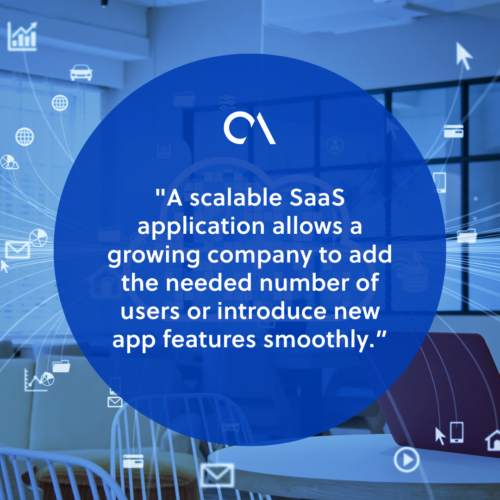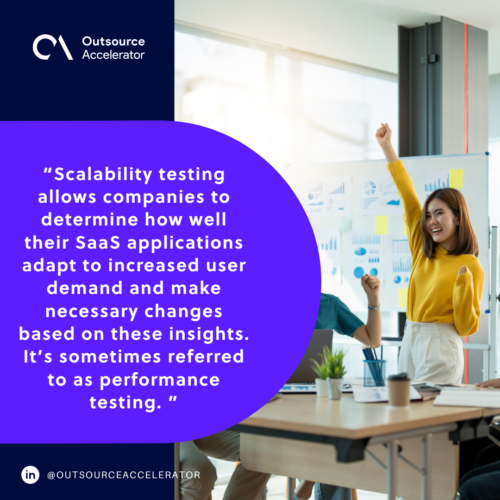How to build more scalable SaaS applications

This article is a submission by Itransition. Itransition is a global provider of software engineering and consulting services, operating in 40+ countries wiith offices in the US and Europe, their team of over 3,000 professionals strive to deliver business value through technology.
Technology vendors across the globe are investing in SaaS application development to capitalize on enterprise-grade or consumer-oriented SaaS products.
According to Research and Markets, the global SaaS market reached $248.76 billion in 2023. Growing at a CAGR of 6.2%, the market is expected to hit $325.84 billion by 2028.
The key reason why technology providers choose SaaS instead of traditional software delivery models is the possibility of stable income from recurrent user payments.
However, if a SaaS vendor wants to steadily grow its subscriber base and ensure long-term revenue growth, it needs to ensure superior scalability of its SaaS app.
This article explores the concept of scalability in SaaS app development and provides four recommendations on how tech companies can build more scalable SaaS apps.
What is scalability in SaaS applications, and why does it matter?
Scalability refers to the ability of a SaaS solution to work stably under increasing workloads. A scalable SaaS solution can:
- Operate steadily and does not slow down despite the growing number of processed user requests
- Process growing volumes of data
- Expand and grow on a company’s demand
Scalability is critical for both consumer-oriented and enterprise SaaS products.
It allows technology SaaS vendors to grow and expand their customer base without the risk of downtime or poor performance. They can easily modify their solutions to meet changing market conditions.
Scalability is also important for companies that use SaaS products to support their internal business processes.
A scalable SaaS application allows a growing company to add the needed number of users or introduce new app features smoothly. They won’t need to worry about IT infrastructure limitations.

How do you make a SaaS application more scalable?
Here are four tips for building a more scalable SaaS application.
1. Choose microservices-based architecture
In many ways, the scalability of a SaaS solution depends on its architecture, which is determined long before the actual development and coding starts. A company that initiates SaaS development has two main architecture options: a monolithic or a distributed one.
Monolithic architecture
A monolithic architecture is a viable option, as they are easier to develop, deploy, and test. However, it may not be the best choice if scalability is a company’s top priority.
This is because, in a monolithic architecture, all software components are integrated into a single codebase. Modifying or replacing even one component can compromise the SaaS solution, so scaling such software can be complex and risky.
Distributed architecture
Unlike a monolith, where all components are tightly coupled, a distributed architecture separates components into smaller, independent pieces of software, such as microservices.
Since all microservices operate independently, they can be tested, deployed, and modified separately. This advantage allows developers to modify and scale each microservice up more smoothly, depending on the company’s business requirements.
Despite the advanced scalability, microservices architecture also has some drawbacks, so consider this option wisely.
In particular, solutions with microservices architectures can be complex and expensive to maintain. Developers need to support dozens or hundreds of services instead of a single monolithic software unit.
Additionally, given that each microservice may be written with different programming languages, microservice architecture may require advanced software development competencies and skills.
2. Select more scalable databases
The choice of one or another database type can also be critical for the SaaS application’s scalability. The system’s overall performance and resistance to high loads largely depend on it.
While both relational and NoSQL databases can provide unique business benefits, distributed NoSQL databases can often be a better option for the app’s scalability.
Such databases can be scaled horizontally across a network of interconnected servers. Each can support specific database functions, which can accelerate query processing.
Also, they can be scaled smoothly across multiple virtual machines. The result is that this distributed architecture can be particularly easily implemented in cloud computing environments.
Many cloud providers offer NoSQL databases as a fully managed service, such as:
- Amazon DynamoDB
- Azure Cosmos DB
- Oracle Autonomous Database
By using these services, companies can enable their apps to handle increased traffic and meet user influx smoothly.
3. Implement load balancing
Companies can increase the scalability of their SaaS software by applying load balancing techniques.
Load balancing enables the optimal distribution of user requests between different cloud app servers. This allows companies to ensure fault tolerance and high performance of their SaaS software, even with a sharp increase in incoming network traffic.
The most popular cloud providers, such as Azure, Oracle, or AWS, provide load balancing tools that SaaS vendors can use.
For example, AWS offers Elastic Load Balancing, a solution that automatically routes incoming app traffic among multiple EC2 instances. Azure Load Balancer is another load balancing tool that efficiently distributes network traffic among Microsoft’s virtual machines.
4. Perform scalability testing
Scalability testing allows companies to determine how well their SaaS applications adapt to increased user demand and make necessary changes based on these insights. It’s sometimes referred to as performance testing.
There are several reasons why scalability testing is essential:
- Analyzing parameters such as response time, loading time, or network throughput lets developers determine how quickly a system responds in high-load conditions.
- By running scalability tests, developers can determine the optimal number of concurrent users.
- Developers can not only identify and eliminate critical bugs at early development stages. They can also discover factors limiting the scalability of their software that are related to IT infrastructure and mitigate them later on.

Developing scalable SaaS applications through external providers
A growing number of companies are choosing the SaaS model for software development to provide flexible, easy-to-maintain, and scalable digital solutions to their customers.
To reiterate, companies can further maximize the scalability of their SaaS applications through the following solutions:
- Implementing microservices-based architecture
- Using NoSQL databases
- Implementing load balancing
- Running scalability tests.
However, developing a highly scalable SaaS solution can be overwhelming and requires advanced development skills that not every company has in-house.
In this case, companies can consider turning to third-party SaaS developers. These professionals can develop SaaS software end-to-end or join the company’s in-house IT team to help create a scalable and future-proof SaaS application.







 Independent
Independent




